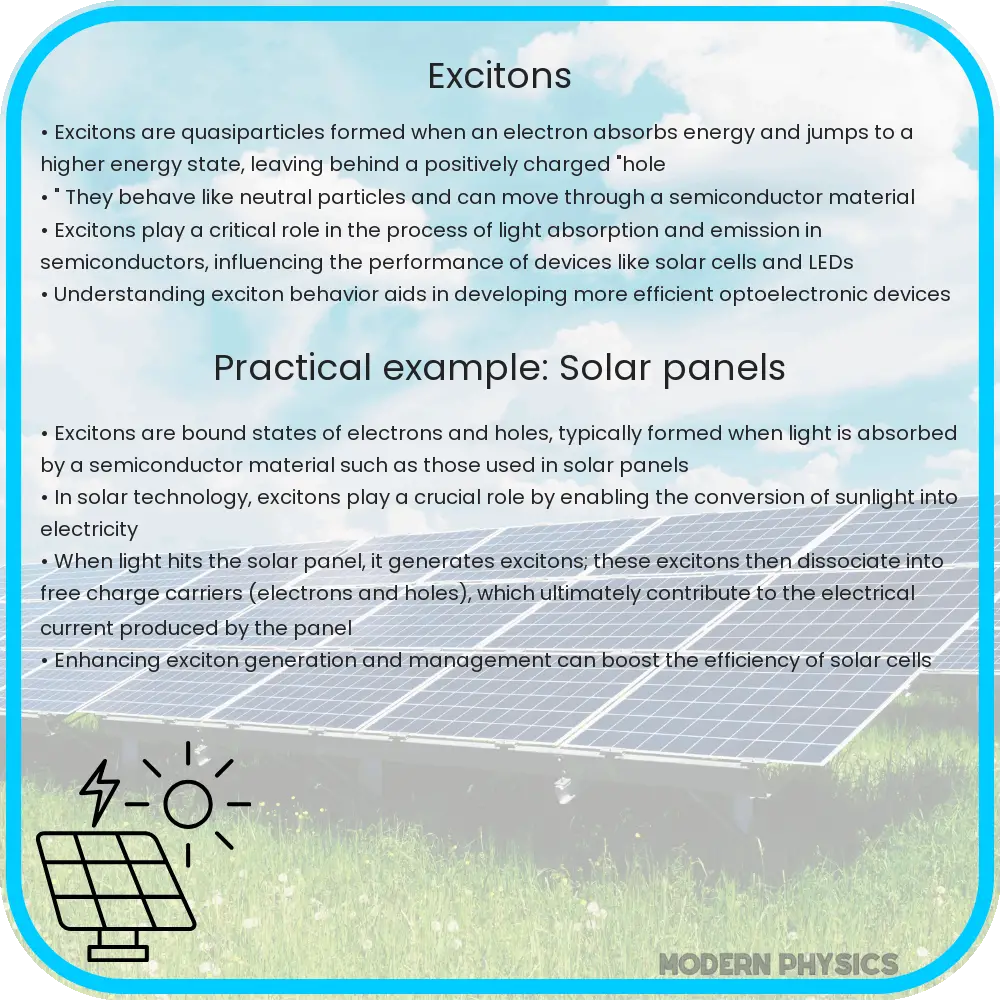Explore the fascinating world of excitons in solid-state physics, their properties, dynamics, and applications in technology, from solar cells to quantum computing.

Understanding Excitons in Solid State Physics
Excitons are quintessential to understanding the optical properties and electronic processes in solid-state materials. An exciton is formed when an electron in the valence band absorbs a photon and is excited to the conduction band, leaving behind a positively charged hole. This electron-hole pair, bound by Coulombic attraction, behaves as a quasi-particle, which plays a critical role in the optical phenomena of semiconductors and insulators.
Properties of Excitons
The unique properties of excitons are central to their functionality in solid-state physics. Firstly, excitons have a characteristic energy spectrum, distinct from the free electron and hole, due to their interaction. This results in sharp absorption peaks in the optical spectra of materials. Moreover, excitons can be categorized into two types: Frenkel excitons, typical in materials with strong electron-hole binding (like organic crystals and some insulators), and Wannier-Mott excitons, found in semiconductors with a weaker electron-hole interaction and larger radii.
Dynamics of Excitons
The dynamics of excitons, including their formation, migration, and recombination, are crucial for the optical properties of materials. After formation, excitons can move through the material via diffusion or drift in an electric field, until they recombine. The recombination can be radiative, emitting a photon, or non-radiative, transferring energy to lattice vibrations. The balance between these processes determines the efficiency of light-emitting devices, such as LEDs and laser diodes.
Applications of Excitons
Excitons are instrumental in a wide range of applications within solid-state physics and beyond. They are key to the operation of photovoltaic cells, where exciton dissociation into free charge carriers is a critical step in converting light into electrical energy. Additionally, in light-emitting diodes (LEDs) and lasers, the radiative recombination of excitons produces light. Furthermore, the study of excitons contributes to the development of excitonic insulators, materials that exhibit a gap in their excitonic excitation spectrum, offering potential for new electronic devices.
The investigation of excitons not only deepens our understanding of the fundamental processes in materials but also paves the way for innovative technologies in electronics, optoelectronics, and energy conversion. The ongoing research in exciton physics promises to unlock new functionalities in materials, offering exciting prospects for future applications.
Understanding Excitons in Solid State Physics
Excitons play a pivotal role in the field of solid-state physics, bridging the gap between the microscopic quantum world and macroscopic material properties. These quasiparticles are formed when an electron in the valence band absorbs energy and jumps to the conduction band, leaving behind a positively charged “hole. The electron and hole, attracted by their opposite charges, orbit each other and create a bound state known as an exciton.
Properties and Dynamics of Excitons
The unique properties of excitons are defined by their binding energy and radius, which dictate their stability and interaction with matter. The binding energy of an exciton is typically in the range of a few meV to hundreds of meV, influencing how excitons behave under various temperatures and electromagnetic fields. The dynamics of excitons, including their formation, migration, and recombination, are crucial for understanding the optical and electronic properties of materials.
Applications of Excitons
Excitons have found applications in a wide range of technologies, from solar cells and light-emitting diodes (LEDs) to lasers and quantum computing. In photovoltaics, excitons contribute to the efficient conversion of sunlight into electricity by facilitating the separation of charge carriers. In LEDs, the recombination of excitons results in the emission of light, enabling the creation of devices with high luminous efficiency and color purity. Furthermore, the quantum properties of excitons are being explored for potential use in quantum computing and information processing, where they could serve as qubits or be used in quantum entanglement experiments.
Conclusion
The study of excitons is a vibrant and rapidly evolving area of solid-state physics, offering insights into the fundamental interactions between light and matter. By understanding the properties and dynamics of excitons, scientists and engineers can devise new materials and technologies with enhanced performance and novel functionalities. Whether it’s improving the efficiency of solar cells, developing brighter and more energy-efficient displays, or paving the way for quantum technologies, excitons continue to be at the forefront of scientific research and technological innovation.
